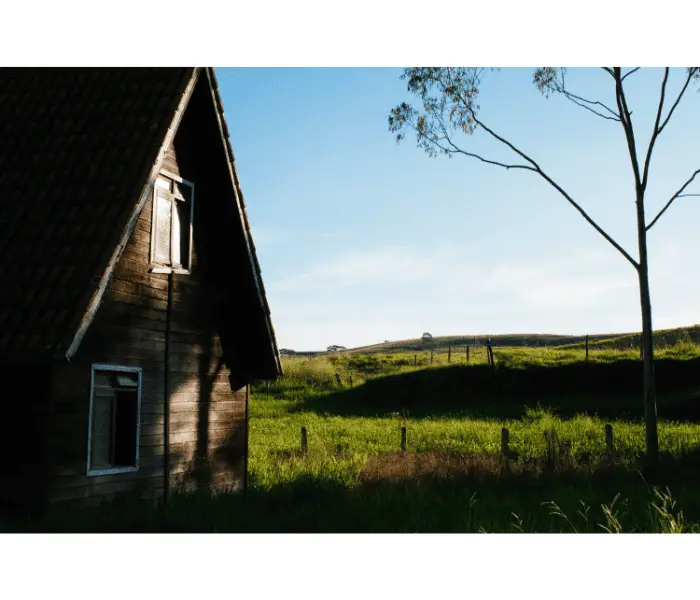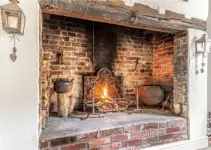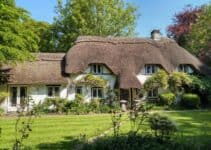Cottages and farmhouses are probably some of the most similar types of property in the British countryside. However, there are enough differences for them to be distinct, and it should be easy to tell them apart once you’ve got a good idea.
In this article, we’ll look at the similarities and differences between cottages and farmhouses. The best place to start, as usual, is with a definition.

What Defines Cottage Style?
A cottage or cottage-style home is usually a small property with 2-3 bedrooms. Traditionally, cottages were defined as not having any land belonging to them, aside from a small garden.
This isn’t as much the case anymore because most of us would consider a garden to be attached land (at least compared to something like an inner-city flat!).
We can also consider cottage style to be a type of interior design. It refers to soft colours, old or antique-style furniture, and natural materials.
Another name for this is cottagecore, which includes handmade decorations and rustic touches.
What is Considered Farmhouse Style?
A farmhouse is typically a property located on a farm where the farmer and their family live. While this isn’t a particularly in-depth definition, it’s arguably the best way of describing a farmhouse.
Due to the nature of its location and purpose, a farmhouse will usually be bigger than a cottage. Granted, it’ll likely still only have 2-3 bedrooms, but they’ll be bigger and there will be more space downstairs.
Also, for old buildings at least, it isn’t uncommon for there to be pigsties, wood sheds, or other structures attached directly to the farmhouse.
In terms of interior farmhouse style, it’s pretty similar to cottage style. Farmhouse favours simpler furniture, such as unpainted wood, and white walls and stone floors.
It also includes textiles, but these are fairly sparing. For example, you’ll find a rug and some cushions but not loads more.

Cottage vs Farmhouse Exterior
On the outside, cottages and farmhouses are pretty similar. Apart from their size, there’s very little to differentiate them. Both typically have:
· Pitched roofs
· Small windows
· Stone or brick walls, which may be whitewashed
However, cottages may have thatched roofs, whereas farmhouses will usually be tile or slate. This is mainly because cottages can be older, and by the time farmhouses as a building style became popular, thatched roofing was on its way out.
Farmhouses are generally Victorian at the earliest, whereas cottages can be much older. This isn’t a set rule but is a fairly accurate assumption to go by.
The easiest way to tell the difference between a farmhouse and a cottage from its exterior will be the size. Cottages are typically small properties that will be square or a small rectangle.
Farmhouses, on the other hand, are usually longer and have extra buildings attached.
To make it a bit more confusing, you can also have farmhouse cottages. However, like other farmhouses, these are usually located on a farm, or at least a large piece of land.
So, if you see something you think is a farmhouse cottage surrounded by a lot of land, you can just call it a farmhouse!
Similarities Between Farmhouses and Cottages
Farmhouses and cottages are fairly similar buildings and interior décor styles. These similarities include:

Rustic Nature
This applies mainly to interiors, but both favour rustic decoration styles. This means lots of wood, distressed appearances, cosy feelings, and practicality.
Age
Cottages and farmhouses are both fairly old construction styles. Cottages as a concept date back to the Middle Ages, although the oldest ones you’ll usually find in the UK are from the 1600s or so.
Farmhouses, however, started in the 18th century, but most ones you’ll see are from the Victorian Age. Despite it being a period of industrialisation, this idea extended to rural settings too.
Colours and Tones
Both cottages and farmhouses favour calming and neutral colours. White is popular as both an exterior and interior colour. In the past, it was one of the easiest colours to make (using limestone), so it was cheap and accessible, even to poor people.
Similarly, both use neutral and earthy tones because of all the wood and stone. While furniture and floors can be painted, it’s perfectly common for them to be left untreated. You’ll also find warm tones from aspects such as brick and tile.
Differences Between Farmhouses and Cottages
However, both cottages and farmhouses are unique in their styles. This leads to the following differences:
Location
Farmhouses will always be in a rural or agricultural setting. Granted, this doesn’t apply as much in a country like the US, but it’s the case in the UK. After all, agriculture used to be a big business in Britain, and the clue is in the property’s name.
Cottages, however, can be anywhere from a rural to an urban setting. The style is mostly defined by the size (at least in a modern understanding).
For example, it wouldn’t be out of place to see a row of terraced cottages in a seaside town or mining city.
Simplicity
Both cottage and farmhouse styles favour simplicity. But cottage style is more romantic and will often include soft colours over natural finishes.
Farmhouses, on the other hand, are often simple and practical. Similarly, farmhouse furniture will usually be practical rather than decorative.
Granted, this isn’t always the case, as interior styles are adaptable, and both have fairly simple exteriors.
A working farmhouse will usually retain its practical nature because it’s an extension of the workplace on which it’s situated.
Cottages, however, aren’t working buildings anymore, so residents can be a bit more showy with their interior decoration.
Cottage Farm House – A Summary
This pretty much sums up the differences between cottage vs farmhouse. From the outside, it’s not always easy to tell the difference, particularly because you can have farmhouse cottages!
But the easiest way to know which type of property you’re looking at is to consider its location. After all, if it’s on a farm or large piece of land, it’s most likely a farmhouse.



